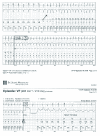Cardiac Arrest following a Myocardial Infarction in a Child Treated with Methylphenidate
- PMID: 26221559
- PMCID: PMC4499390
- DOI: 10.1155/2015/905097
Cardiac Arrest following a Myocardial Infarction in a Child Treated with Methylphenidate
Retraction in
-
Retracted: Cardiac Arrest following a Myocardial Infarction in a Child Treated with Methylphenidate.Case Rep Pediatr. 2021 Jan 28;2021:4712417. doi: 10.1155/2021/4712417. eCollection 2021. Case Rep Pediatr. 2021. PMID: 33628557 Free PMC article.
Abstract
The use of psychostimulants labeled to treat attention deficit/hyperactivity disorder increases. Among side effects these drugs raise blood pressure and heart rate, and the safety has been scrutinised in recent years. Data from large epidemiological studies, including over a million person-years, did not report any cases of myocardial infarction in current users of methylphenidate, and the risk of serious adverse cardiac events was not found to be increased. We present a case with an 11-year-old child, treated with methylphenidate, who suffered cardiac arrest and was diagnosed with a remote myocardial infarction. This demonstrates that myocardial infarction can happen due to methylphenidate exposure in a cardiac healthy child, without cardiovascular risk factors.
Figures



References
-
- Volkow N. D., Wang G.-J., Fowler J. S., et al. Cardiovascular effects of methylphenidate in humans are associated with increases of dopamine in brain and of epinephrine in plasma. Psychopharmacology. 2003;166(3):264–270. - PubMed
Publication types
LinkOut - more resources
Full Text Sources
Other Literature Sources

